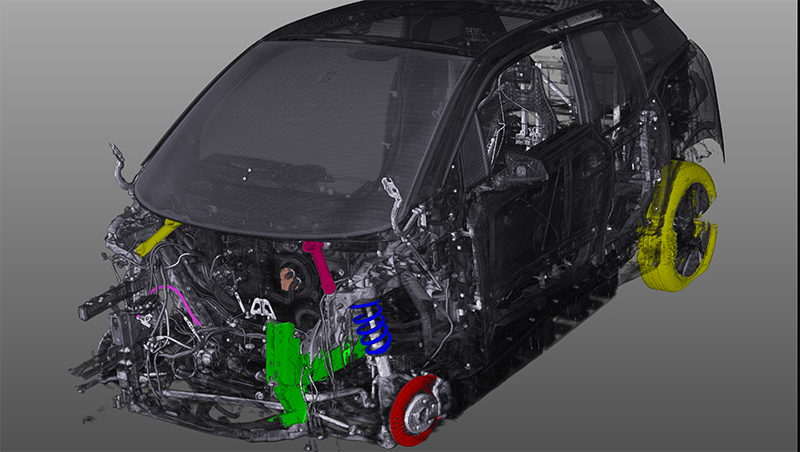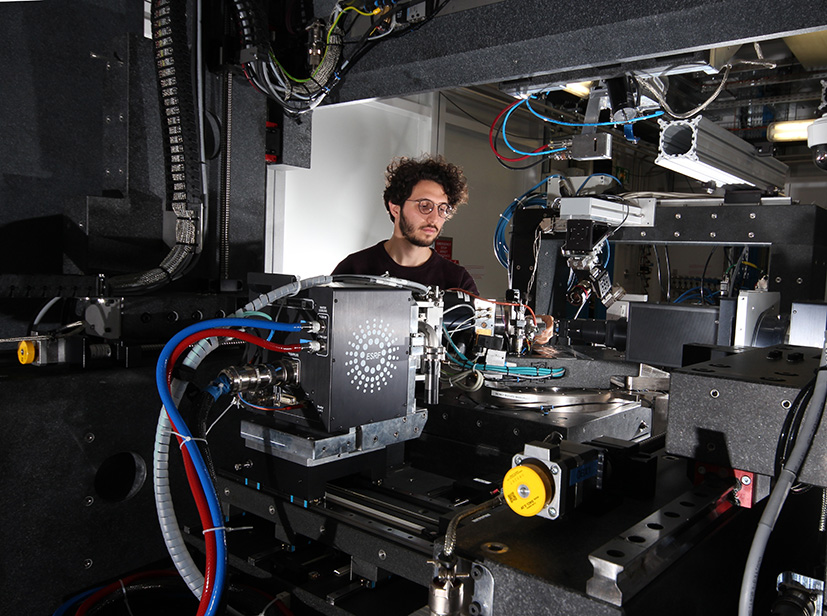- Home
- Industry
- Industry news
- Four new beamlines...
Four new beamlines planned will offer new opportunities for industrial research
11-10-2017
The Extremely Brilliant Source, the new machine the ESRF is currently building, will have four new beamlines with new opportunities for industrial research. After an 18 months shutdown starting at the end of 2018, the ESRF will come back with an extremely powerful machine that will enable scientists and industrial clients to carry out experiments which are currently impossible.
Big objects under synchrotron X-rays
High Throughput Large Field Phase-contrast Tomography
X-ray tomography is a technique that is extensively used by both academic and industrial users. Due to its success, and in view of benefitting both communities, the ESRF will build a new high-quality synchrotron tomography beamline. This beamline will allow researchers to study large objects which are currently only studied in lab sources but with much higher precision and sensitivity.
It will
- Have a large beam at high energy, which will make it possible to study very large samples (300kg, up to 60 cm diameter and in 2.5 m height).
- Be optimized for semi-automatic operations, especially for multiresolution applications.
- Allow high quality phase contrast even at very high energy on large objects.
CASE STUDY: ASSESSING DAMAGE OF IMPACT ON LARGE CAR COMPONENTS
Aerospace and automotive manufacturers will benefit from a facility where they can study large pieces of steel, such as car doors before and after a crash test. They will be able to track any structural changes and to determine whether those can modify their properties.
 |
|
Different parts of cars will be able to be studied on the new beamline focused on High Throughput Large Field Phase-contrast. Credits: Fraunhofer IIS. |
Multiscale analysis of engineering metals
Hard X-ray Diffraction Microscopy
Dark field x-ray microscopy is a new technique in synchrotrons that allow to study materials at different scales. It is based on diffraction by the sample, and is therefore sensitive to microscopy crystallographic details of materials like most metals, ceramics, rocks, semiconductors, biominerals, etc. Many physical and mechanical properties of these materials depend on their internal structure, organised into grains of different sizes.
Dark field x-ray microscopy will allow users to
- Carry out 3D mapping of orientation and stresses.
- Use sample sizes up to 1 milimetre.
- Zoom in and out in both direct and angular space, with resolution down to 100nm and 10-4 deg, respectively.
- Monitor the evolution of a sample as it undergoes thermal or chemical processes.
CASE STUDY: FOLLOWING METALLURGICAL REACTIONS LIVE IN 3D
Iron nitrides are used to process steel as thermochemical treatment on the alloys (also called case hardening) and can be used to significantly improve surface and bulk properties. Controlling the nucleation and growth of nitride phases is essential for macroscopic properties of these alloys. Researchers can now see the internal structure of steel alloys and follow which processes occur on sub-micron scale in operando conditions.
 |
|
Beamline ID06 is a predecessor of the new beamline on Hard X-ray Diffraction Microscopy. Credits: Jeff Wade. |
More efficient drug design studies
Serial Macromolecular Crystallography
Serial Macromolecular Crystallography is the emerging technique that permits to reconstruct a complete molecular reciprocal space by combining single diffraction patterns collected from thousands of microcrystals.
The new ID29-SSX long beamline will profit from the ESRF - Extremely Brilliant Source by delivering an unequalled flux density in a submicron beamsize, over a large energy range.
The new beamline is designed to
- Study systems that cannot produce large crystals.
- Adapt to different crystal delivery methods (Injectors, Fixed target supports, microfluidic devices are examples).
- Open new paths in drug discovery research, thanks to rapid ligand diffusion in microcrystals.
- Exploit time-dependent functional conformation changes upon ligand binding.
CASE STUDY: MORE EFFICIENT DRUG DESIGN STUDIES
With this one-of-a-kind beamline, pharmaceutical companies will be able to unveil macromolecules structures from micro-crystals and optimize sample consumption in a structure based drug design (SBDD) campaign.
Tracking superfast dynamic processes
Coherent X-rays Dynamics and Imaging Applications
Coherent X-rays are ideal to study the hidden space and time correlations in disordered materials (glasses, alloys, etc.) and complex matter (colloidal suspensions, gels, emulsions, microspheres, nano composite, hierarchical tissues).
It will
- Allow the measurements of diffusion processes (diffusion coefficient, viscosity) down to the sub-microsecond time scale.
- Detect relaxation processes at characteristic correlations down to the atomic scale.
- Allow 3D imaging of tiny specimens at few nanometers resolution.
CASE STUDY: STUDYING POROSITY AT THE MESO AND NANOSCALE
Meso and nano-engineered porosity in technologically relevant fields, such as photovoltaic materials, glasses or composites, is one of the important parameters determining the efficiency of the device. By imaging the material in 3D down to the nanoscale, scientists will be able to see the internal porosity and evaluate parameters, e.g. the surface-to-volume ratio and specific surface, with the aim to tailor materials' properties.
Top image: A 3D picture of a car motor, which scientists will be able to study in the new beamline on High Throughput Large Field Phase-contrast. Credits: Fraunhofer IIS.



